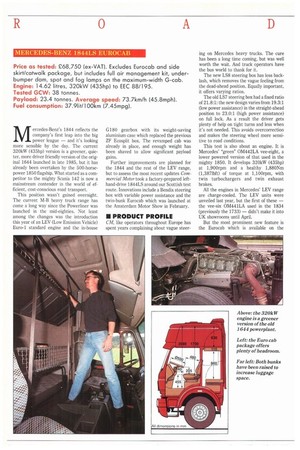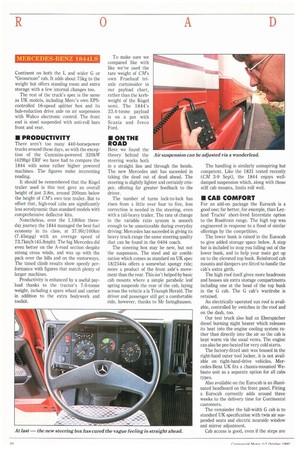M ercedes-Benz's 1844 reflects the company's first leap into the big
Page 32

Page 34

Page 35

If you've noticed an error in this article please click here to report it so we can fix it.
power league — and it's looking more sensible by the day. The current 320kW (435hp) version is a greener, quieter, more driver friendly version of the original 1644 launched in late 1985, but it has already been overtaken by the 500-horsepower 1850 flagship. What started as a competitor to the mighty Scania 142 is now a mainstream contender in the world of efficient, cost-conscious road transport.
This position wasn't gained overnight. The current M-B heavy truck range has come a long way since the Powerliner was launched in the mid-eighties. Not least among the changes was the introduction this year of an LEV (Low Emission Vehicle) Euro-1 standard engine and the in-house G180 gearbox with its weight-saving aluminium case which replaced the previous ZF Ecosplit box. The revamped cab was already in place, and enough weight has been shaved to allow significant payload gains.
Further improvements are planned for the 1844 and the rest of the LEV range, but to assess the most recent updates Commercial Motor took a factory-prepared lefthand-drive 1844LS around our Scottish test route. Innovations include a Bendix steering box with variable power assistance and the twin-bunk Eurocab which was launched at the Amsterdam Motor Show in February.
• PRODUCT PROFILE
CM, like operators throughout Europe has spent years complaining about vague steer
ing on Mercedes heavy trucks. The cure has been a long time coming, but was well worth the wait. And truck operators have the bus world to thank for it.
The new LS8 steering box has less backlash, which removes the vague feeling from the dead-ahead position. Equally important, it offers varying ratios.
The old LS7 steering box had a fixed ratio of 21.8:1: the new design varies from 19.3:1 (low power assistance) in the straight-ahead position to 23,0;1 (high power assistance) on full lock. As a result the driver gets plenty of help on tight turns and less when it's not needed. This avoids overcorrection and makes the steering wheel more sensitive to road conditions.
This test is also about an engine. It is Mercedes' "green" 0M442LA vee-eight, a lower powered version of that used in the mighty 1850. It develops 320kW (435hp) at 1,900rpm and a healthy 1,880Nm (1,3871hft) of torque at 1,100rpm, with twin turbochargers and twin exhaust brakes.
All the engines in Mercedes' LEV range are charge-cooled. The LEV units were unveiled last year, but the first of these — the vee-six 0M441LA used in the 1834 (previously the 1733) — didn't make it into UK showrooms until April.
But the most prominent new feature is the Eurocab which is available on the Continent on both the L and wider G or "Grossraum" cab. It adds about 75kg to the weight but offers standing room and extra storage with a few internal changes too.
The rest of the truck's spec is the same as UK models, including Merc's own EPScontrolled 16-speed splitter box and its hub-reduction drive axle on air suspension with Wabco electronic control. The front end is steel suspended with anti-roll bars front and rear.
• PRODUCTIVITY
There aren't too many 440-horsepower trucks around these days, so with the exception of the Cummins-powered 320kW (429hp) ERF we have had to compare the 1844 with some rather higher powered machines. The figures make interesting reading.
It should be remembered that the Kbgel trailer used in this test gave an overall height of just 3.8m, around 200mm below the height of CM's own test trailer. But to offset that, high-roof cabs are significantly less aerodynamic than standard models with comprehensive deflector kits.
Nonetheless, over the 1,180km threeday journey the 1844 managed the best fuel economy in its class, at 37.9lit/100krn (7.45mpg) with an average speed of 73.7km/h (45.8mph). The big Mercedes did even better on the A-road section despite strong cross winds, and was up with the pack over the hills and on the motorways. The timed climb results show speedy performance with figures that match plenty of larger machines.
Productivity is enhanced by a useful payload thanks to the tractor's 7.6-tonne weight, including a spare wheel and carrier in addition to the extra bodywork and toolkit.
To make sure we compared like with like we've used the tare weight of CM's own Fruehauf triaxle curtainsider in our payload chart, rather than the kerbweight of the Kbgel semi. The 1844's 23.4-tonne payload is on a par with Scania and Iveco Ford.
• ON THE ROAD
Here we found the theory behind the steering works both in a straight line and through the bends. The new Mercedes unit has suceeded in taking the dead out of dead ahead. The steering is slightly lighter and certainly crisper, offering far greater feedback to the driver.
The number of turns lock-to-lock has risen from a little over four to five, less correction is needed in the steering, even with a tail-heavy trailer. The rate of change in the variable ratio system is smooth enough to be unnoticeable during everyday driving: Mercedes has suceeded in giving its heavy truck range the same steering quality that can be found in the 0404 coach.
The steering box may be new, but not the suspension. The steel and air combination which comes as standard on UK spec 18/2544s offers a somewhat spongy ride; more a product of the front axle's movement than the rear. This isn't helped by basic cab mounts where a simple parabolic leaf spring suspends the rear of the cab, laying across the vehicle a la Triumph Herald. The driver and passenger still get a comfortable ride, however, thanks to Mr Isringhausen.
The handling is similarly uninspiring but competent. Like the 1831 tested recently (CM 3-9 Sept), the 1844 enjoys welldamped suspension which, along with those stiff cab mounts, limits roll well.
• CAB COMFORT
For an add-on package the Eurocab is a good one; far better, for example, than Leyland Trucks' short-lived Interstate option to the Roadtrain range. The high top was engineered in response to a flood of similar offerings by the competition.
The lower bunk is raised in the Eurocab to give added storage space below. A step bar is included to stop you falling out of the lower bunk, and to help your mate get up on to the elevated top bunk. Reinforced cab mounts and dampers are fitted to handle the cab's extra girth.
The high roof itself gives more headroom and houses six extra storage compartments including one at the head of the top bunk in the G cab. The G cab's wardrobe is retained.
An electrically operated sun roof is available, controlled by switches in the roof and on the dash, too.
Our test truck also had an Eberspacher diesel burning night heater which releases its heat into the engine cooling system rather than directly into the air so the cab is kept warm via the usual vents. The engine can also be pre-heated for very cold starts.
The factory-fitted unit was housed in the right-hand outer tool locker, it is not available on right-hand-drive vehicles. Mercedes-Benz UK fits a chassis-mounted Webasto unit as a separate option for all cabs types.
Also available on the Eurocab is an illuminated headboard on the front panel. Fitting a Eurocab currently adds around three weeks to the delivery time for Continental customers.
The remainder the full-width G cab is to standard UK specification with twin air suspended seats and electric nearside window and mirror adjustment.
Cab access is good, even if the steps are narrow, Once inside the driver enjoys the full choice of ergonomic adjustments including tilting/telescopic steering column. The large, ungainly EPS control unit continues to clutter the engine cover to further the pretence that it is a mechanical gear stick, We hope the truck-buying public will be educated enough by the time 'EPS 2' arrives for this electronic switch for that is all it is to be positioned somewhere more suitable.
Apart from that the Mercedes cab interior remains the model of self-restraint with no-nonsense instrumentation. The light grey seats help to liven up the practical, if rather boring trim but they'll need looking after if they're not to show the dirt.
• SUMMARY
Even allowing for the low wind resistance afforded by its low semi, the fuel consumption of 37.91it/100km (7.45mpg) delivered by our 1844 is commendable.
Its new steering box tackles a regular complaint from past roadtests. Another advantage is that the new unit is designed to last as long as the vehicle, subject to the correct lubrication maintenance.
The 1844's transformation from 1985 flagship to 1992 long-distance hauler is complete in all but three important respects. What might turn out to be called EPS 2, with its potential to be a clutchless system, might require more driver training but it would complete the move away from
a simple metal stick. Also awaited are Mercedes' much heralded front disc brakes. These are well past the engineering stage for most models but, like many recent developments in the truck world, won't see the light of day until there are buyers in significant numbers.
And the high-roof cab, which is a standard fitting on the Continent, is not yet available for right-hookers. Like the discs, Mercedes is doubtless waiting to see if the size of market would justify its large development costs.
But when it comes to the Eurocab British hauliers really should not be kept waiting too much longer.
O by Danny Coughlan
















































































